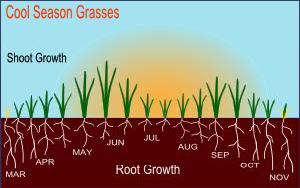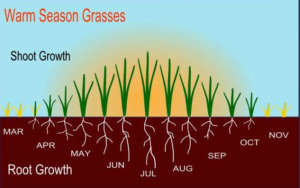Grass types that are used for lawns are classified into two groups either cool-season or warm-season species.
The cool-season grasses grow best in the northern parts of the United States. The intensity of summer heat and drought stress limits how far south they can grow.
Alternately, warm-season grasses flourish in the southern heat and the northern boundaries of adaptation are dictated by the intensity and duration of winters.
The area sandwiched between the northern (cool) and southern (warm) growing zones is known as the Transition zone. Both warm and cool-season species can be grown in this region. However, no turfgrass species is perfectly adapted and seasons with weather extremes will cause the most carefully selected variety to struggle or even die.
- Link to Grass Identification Glossary and Diagrams
- Get a Smart Lawn Plan that’s customized for your grass type, climate and soil.
What we cover
ToggleCool-Season Grasses
Cool-season species grow best in cool temperatures, optimal growth takes place between 60° to 75° F. A typical growing season starts with a flush of growth in the spring, then slowed (sometimes to dormancy) in the summer, followed by another flush of growth in the fall. Cool-season lawns are dormant through the winter.
These lawns need to be watered during hot, dry periods or they will go dormant and turn brown. Lawns that go into dormancy due to heat and drought can be injured or even die. Many cool-season species will retain a green color in climates with mild winters such as the Oceanic climate of the Pacific Northwest.

Best shoot growth is when air temperatures are between 60° – 75° F. Best root growth is when soil temperatures range between 50° – 65° F.
The best cool-season grasses for US lawns:
- Kentucky bluegrass
- Fine fescues
- Turf type Tall fescue
Perennial ryegrasses are mainly used in seed blends as a nurse grass, because of their quick germination rate, and for overseeding warm-season species.
Bentgrass is another common cool season species – used mainly on golf course greens and tees. It can make a really nice lawn but is very high maintenance. In some areas, bentgrass can be an invasive weed that is difficult to control.
Warm-Season Grasses
Warm-season species are best suited to the tropical and subtropical climates of the southern and southwestern regions of the United States. A typical annual growth cycle begins with a slow green up in the spring as temperatures rise, thrives during the warmer temperatures – optimal growth is between 80° to 90° F degrees – and then goes dormant and turns brown when the weather gets cold. Warm-season lawns are more heat and drought-tolerant than cool-season lawns making them a good option for warm semi-arid and arid regions.

Best shoot growth is when air temperature is between 80° – 95° F. Best root growth is when soil temperatures range between 75° – 85° F.
Southern lawns are sometimes overseeded with a cool-season species in early fall to maintain a green color through the winter. In addition to providing a green cover, overseeding also protects dormant warm-season grasses from extreme cold temperatures and traffic wear.
Popular warm-season grasses for US lawns:
- Bermudagrass
- Bahia grass
- Buffalo grass
- Centipedegrass
- Carpetgrass
- St. Augustine grass
- Zoysia grass
Transition Zone Grasses
Year-round weather conditions are less than ideal for both types of grasses, making this area the most difficult to grow a beautiful, environmentally friendly lawn. The winters can be too cold for many warm-season species and the summers too hot and dry for many cool-season species.
Tall fescue is the most common and best-adapted transition grass type in the eastern transition zone. Kentucky bluegrass, bermudagrass and zoysiagrass can be used on certain sites. Buffalograss is a good choice for unirrigated lawns in western semiarid regions.
Humid Continental summers are typically warm to hot and humid while winters are cold (sometimes severely cold in northern areas). Precipitation is usually distributed throughout the year. Cool-season grasses are best adapted to this climate.
Humid subtropical climate is characterized by hot and humid summers and mild winters. Rainfall peaks during the summer months with most rainfall occurring during thunderstorms. Warm-season grass types are best adapted to subtropical climates.
Tropical climate is a non-arid climate where temperature remains hot throughout the year (mean temperatures of warmer than 64 °F). There are often only two seasons: a wet season and a dry season. Tropical climates are frost-free. Warm-season grasses are adapted to tropical climates.
Oceanic (marine) climates feature mild summers and mild winters with few temperature extremes. Cool-season grasses such as Kentucky bluegrass, perennial ryegrass, and turf-type tall fescue are well adapted to the oceanic climate of the Pacific Northwest.
Mediterranean climates are characterized by rainy winters and dry summers. Several warm-season grasses as well as drought and heat-tolerant cool-season grasses such as turf-type tall fescue, are suitable for Mediterranean climates. Irrigation is required during the dry summer season to maintain a healthy lawn.
Arid (desert) and Semi-arid climates are dry climates. Irrigation is required in dry climates. Cool-season grasses can be grown in the cool arid (Northern and high elevation sites) and warm-season grasses in the warm arid climates. Choose species that are the most drought tolerant such as tall fescue or buffalograss.
This is a simplified map that classifies mountainous regions as Highlands climate. In these areas, there is a lot of microclimate diversity and due to the dramatic changes in altitude and relief, these climates cannot be mapped at a continental scale. The climate of mountainous regions tends to be cooler and wetter than the surrounding lowlands so cool-season grass types are best adapted to these regions.
